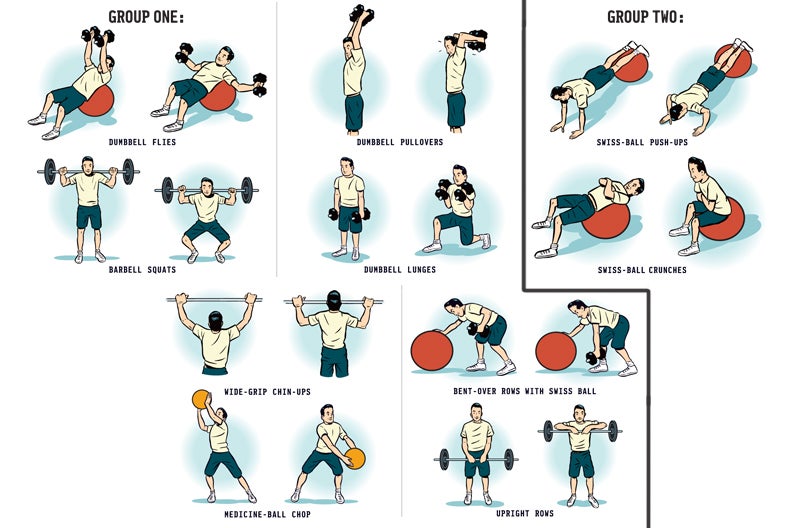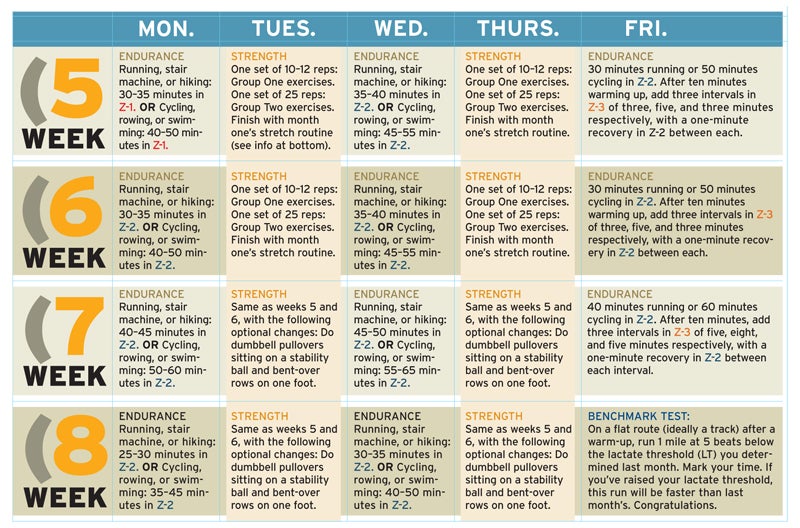Inisde the typical foghat-themed weight room you'll find two typical users: bronzed apes getting ripped by hogging the bench, leg sled, and mirrors; and past-their-prime athletes hoping to cut an old squash injury off at the pass with a lazy machine circuit. Too bad. Not only are such routines mind- and soul-numbing, but because they're derived from bodybuildingÔÇöa dubious athletic niche that treats muscles as trophies rather than team membersÔÇöboth are fundamentally flawed. For the kind of usable musculature that may not seal the deal on ElimiDate but will sharpen your prowess on the trail, slopes, or river, it's time to embrace functional training, an approach to lifting that mimics movements actually involved in sports.
“You need to train in patterns that reflect life,” says Paul Chek, the country's best-known functional-fitness evangelist. Chek developed many of the movement's tenets at his . Rather than isolating individual muscles, functional exercises follow the three basic motions of athletics (rotational, side-to-side, and front-to-back) to recruit entire muscle groups, and put you on your feet rather than a padded bench. When you're forced to maintain your balance while moving weight, you strengthen your core, an oft-neglected muscle group comprising your glutes, lower back, and abdominals. A solid core is vital for transferring power from lower body to upper bodyÔÇölike when lifting a 60-pound pack onto your backÔÇöor vice versa. “If your core is deficient,” says Chek, “your arms and legs have nothing to anchor to.”
Much to the weight-machine industry's chagrin, functional training has become more than the pet theory of a handful of personal trainers. The recently developed a functional-training certification program. And prior to the last two Olympics, U.S. athletes were using functional regimens to prepare for everything from triathlon to alpine skiing. “Ninety percent of our training involves movements that mimic sport,” says Dana Healy, director of conditioning at the in Colorado Springs. “It makes more senseÔÇöhow does a Nautilus curl transfer over to everyday activity?”
This month, in part two of our Shape of Your Life program, as you continue to build your endurance foundation, we'll introduce a functional-strength regimen for the gym. You'll start with only one set (studies show that one set, done right, has the same benefits as two). You'll put equal emphasis on the down portions of each lift, developing your muscles to descend, not just climb, a mountain. And when you plateau, you'll lift less weight for a day before attempting moreÔÇöa periodization strategy you can think of as “step back and leap.”
All this should be welcome news. By lifting less weight in a smarter fashion, functional training won't tap your endurance resources the way traditional approaches can. (Yes, you will be doing aerobic endurance work in month two). Most of the exercises you'll perform can be adapted; almost anything done on two feet, for example, can be done on one. This should help prevent workout boredom. And most important, you'll nurture real muscular movement for the fieldÔÇönot just the mirror. Which is the only kind of strength you'll ever need.
How to Cut a Killer Core

Weeks five through eight of The Shape of Your Life focus on functional strength. All the moves are simple adaptations of standard weight-room lifts. The key difference is that everything takes place on your feet or a stability ball (you can purchase the latter, also called a Swiss ball, at your local sporting goods store). Lifting on a wobbly platform develops your core, a muscle group that transfers strength gains to real sports. 
Our regimen stresses quality over quantity, so you'll do only one set, but perform each rep in a slow, smooth manner (five to ten seconds each), placing equal emphasis on both the up and down portions of the lift. Use enough weight to bring you just short of exhaustion after ten reps. When it gets easier, increase the weight, slow down the reps, or both. Each workout, complete a ten-minute warm-up before starting, and mix up the order of the exercises; variety will promote continued muscle growth. In month three, you'll perform a simple cable test that can help measure increases in core strength.
For endurance, continue zone heart-rate training three days a week. Weeks five and six use intervals to raise your lactate threshold. To maintain the periodized approach laid out in month one, you'll add time (about ten minutes) to your workouts in week seven, and reduce them in week eight to get you rested for the next phase.

with the second installment in our interactive training plan.


